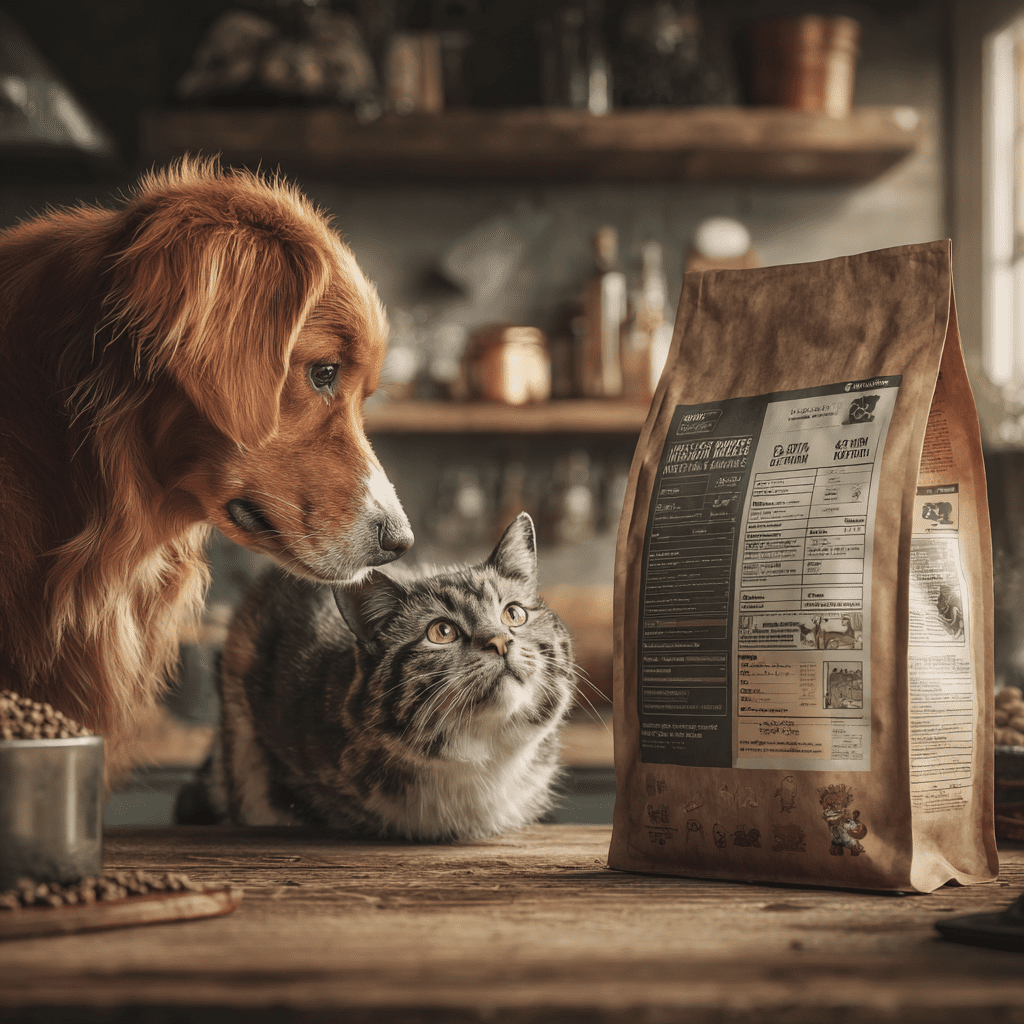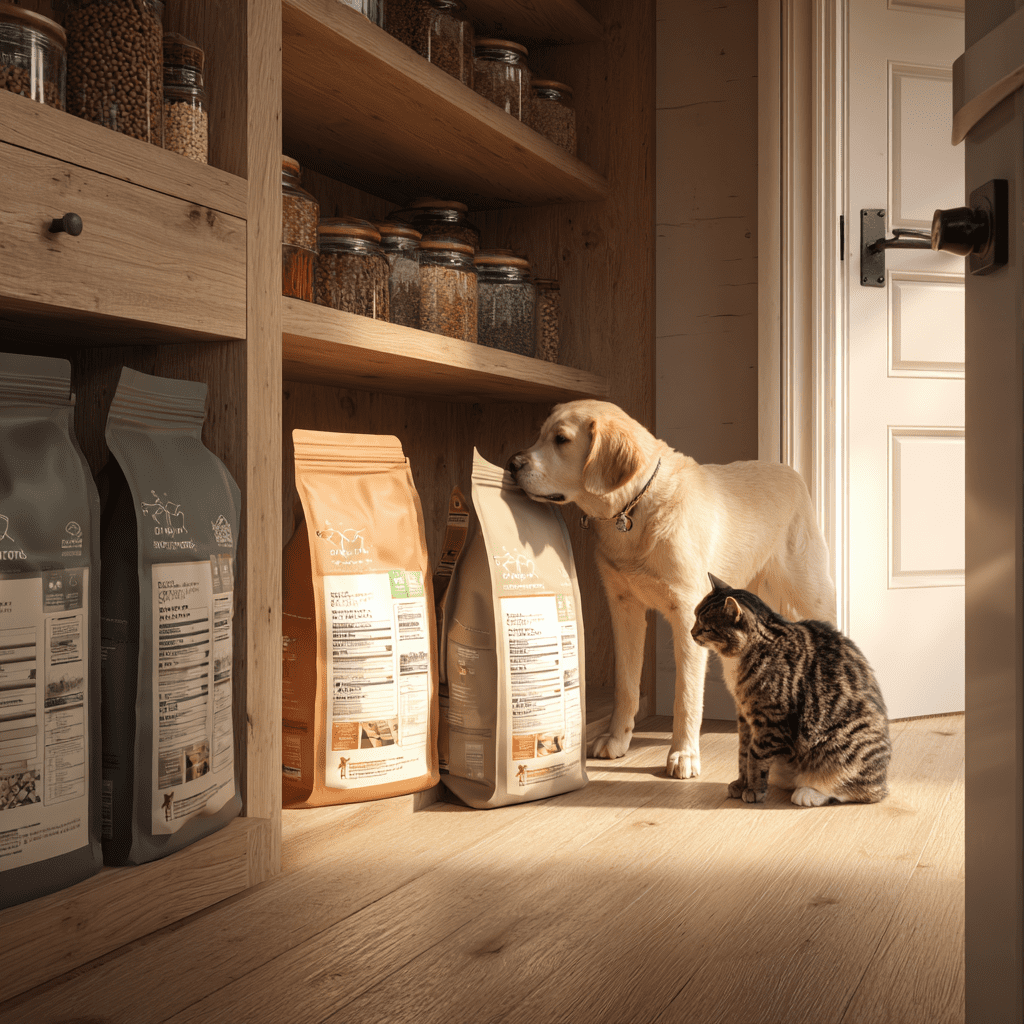🧠 1. Why Labels Matter
Choosing the right pet food is about more than a catchy marketing headline. The pet food label is your best tool for evaluating quality, safety, and nutritional value. It’s regulated by the FDA and AAFCO, so learning how to read labels keeps your pet safe and nourished
2. Principal Display Panel (Front of Packaging)
On the front, you’ll find:
- Product name and brand
- Species specified (e.g. “Dog Food” or “For Cats”)
- Net quantity (weight or volume in pounds and kilograms)
Pro Tip: When the label reads “Beef Dog Food,” that means at least 95% of the formula is beef (excluding water) But “Beef Dinner” means only 25% must be beef, and “Dog Food with Beef” may contain only 3% beef
3. Ingredient List

Ingredients must be listed in descending order by weight—pre-cooked weight, including moisture
Common red flags:
- Ingredients like “meat and bone meal” or “animal digest” can be vague and may contain low-quality by-products
- Any vague terms hide potential allergens or low-value fillers. Instead, look for named meats, whole grains, and specific vegetables.
4. Guaranteed Analysis
This section shows the minimum and maximum percentages of:
- Crude protein
- Crude fat
- Crude fiber
- Moisture
Even though labels don’t list exact amounts, these ranges give a sense of nutrient density.
5. Nutritional Adequacy Statement
This tells you if the food is “complete and balanced” for a certain life stage (e.g., growth, adult maintenance) and whether it’s been:
- Formulated to AAFCO profiles
- OR tested with AAFCO feeding trials
Only foods labeled this way should be fed as the sole diet. Treats and supplements are exempt.
6. Feeding Directions & Calorie Statement
These are practical guides for feeding amounts. However:
- Calories on pet food labels are often missing
- Feeding recommendations are approximate and based on average metabolism
Always use your pet’s body condition to adjust portions rather than relying solely on suggested feeds.
7. Manufacturer Information & Regulatory Info
Every label must include:
- Manufacturer or guarantor name and address
- Contact information in case of recalls or questions
This ensures accountability. Claims like “proven urinary health” must be backed by evidence meeting FDA/AAFCO guidelines
8. Marketing Claims: Beware of Buzzwords
Terms like “natural,” “premium,” “holistic,” or “grain-free” are unregulated and may not reflect the product’s true quality
Even “with beef” doesn’t guarantee high meat content. Look for actual percentages of named ingredients when possible
9. Comparing Grain‑Free vs Grain‑Inclusive
Labels help identify what’s in (and out) of the food:
- Many grain‑free diets rely heavily on peas, lentils, or potatoes.
- Studies show certain grain‑free foods correlate with DCM, likely due to poor formulation and nutrient imbalances—not the lack of grains per
If pulses top the ingredient list, do further research before feeding regularly.
10. How to Read a Label: Step-by-Step Checklist
| Step | What to Check |
|---|---|
| 1 | Product name—does ingredient prominence match your needs? |
| 2 | Ingredient list—named meats first, no vague fillers |
| 3 | Guaranteed analysis—protein ≥18%, fat adequate, fiber low |
| 4 | Nutritional adequacy statement—matches pet’s life stage |
| 5 | Feeding directions—appropriate portion for your pet’s weight |
| 6 | Manufacturer info—reputable, accessible company |
| 7 | Claims—confirm backed by testing or trustworthy sources |
11. Real-Life Examples: What to Avoid & What to Choose
- Bags labeled “Chicken Dinner” but listing corn syrup or by-products in top ingredients—beware.
- Avoid foods with vague “meat and bone meal,” “animal digest.”
- Prefer brands that list named protein sources, grains or alternative carbs clearly, and guarantee balanced nutrients
Selecting a reputable brand that uses quality ingredients and rigorous testing is better than chasing fancy labels.
12. Final Thoughts: Your Best Pet Food Shopping Strategy
- Read labels thoroughly—it’s your best insight into quality.
- Understand that marketing terms may mislead.
- Choose foods with AAFCO-approved adequacy statements.
- If your pet has allergies or health issues, consult your vet for tailored advice based on label info.
